Economics Assignment: Analyzing Drought's Economic Impact on Farmers
VerifiedAdded on 2021/04/17
|9
|1928
|21
Essay
AI Summary
This economics assignment explores the economic impact of drought on farmers, focusing on concepts like inelastic demand, supply and demand curves, and market equilibrium. The analysis demonstrates how drought can paradoxically benefit farmers if their crops face inelastic demand, leading to increased revenue despite reduced supply. The assignment also discusses the role of government intervention, such as rationing, in controlling market supply and influencing crop prices. It contrasts the effects of drought with the challenges farmers face in intentionally reducing production to manipulate market prices, highlighting the risks and uncertainties involved. Furthermore, it underlines the importance of governmental support and the potential for farmers to earn revenue through other economic activities. The study emphasizes that while drought can increase farmers' revenue, intentional crop destruction without government intervention poses significant risks.
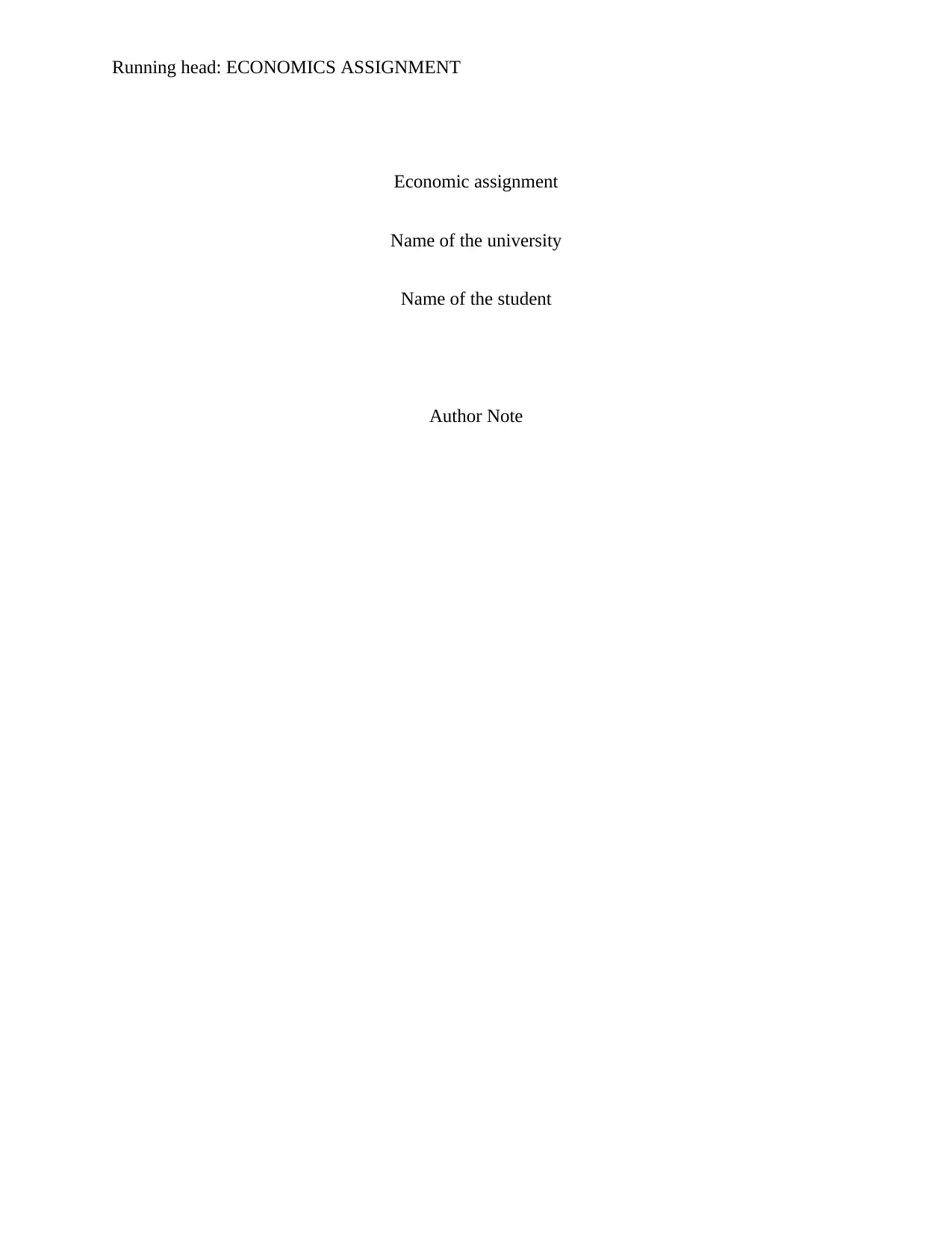
Running head: ECONOMICS ASSIGNMENT
Economic assignment
Name of the university
Name of the student
Author Note
Economic assignment
Name of the university
Name of the student
Author Note
Paraphrase This Document
Need a fresh take? Get an instant paraphrase of this document with our AI Paraphraser
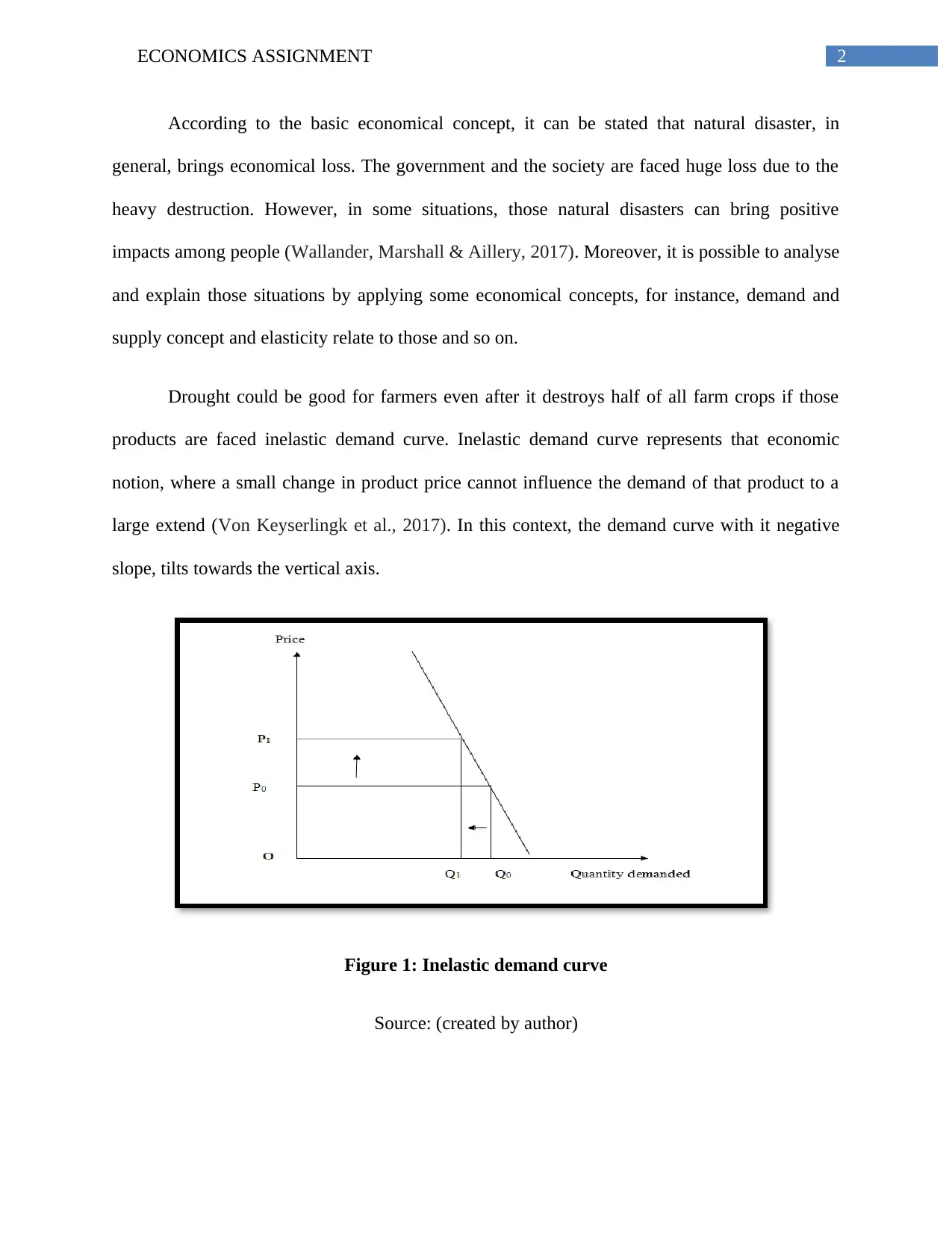
2ECONOMICS ASSIGNMENT
According to the basic economical concept, it can be stated that natural disaster, in
general, brings economical loss. The government and the society are faced huge loss due to the
heavy destruction. However, in some situations, those natural disasters can bring positive
impacts among people (Wallander, Marshall & Aillery, 2017). Moreover, it is possible to analyse
and explain those situations by applying some economical concepts, for instance, demand and
supply concept and elasticity relate to those and so on.
Drought could be good for farmers even after it destroys half of all farm crops if those
products are faced inelastic demand curve. Inelastic demand curve represents that economic
notion, where a small change in product price cannot influence the demand of that product to a
large extend (Von Keyserlingk et al., 2017). In this context, the demand curve with it negative
slope, tilts towards the vertical axis.
Figure 1: Inelastic demand curve
Source: (created by author)
According to the basic economical concept, it can be stated that natural disaster, in
general, brings economical loss. The government and the society are faced huge loss due to the
heavy destruction. However, in some situations, those natural disasters can bring positive
impacts among people (Wallander, Marshall & Aillery, 2017). Moreover, it is possible to analyse
and explain those situations by applying some economical concepts, for instance, demand and
supply concept and elasticity relate to those and so on.
Drought could be good for farmers even after it destroys half of all farm crops if those
products are faced inelastic demand curve. Inelastic demand curve represents that economic
notion, where a small change in product price cannot influence the demand of that product to a
large extend (Von Keyserlingk et al., 2017). In this context, the demand curve with it negative
slope, tilts towards the vertical axis.
Figure 1: Inelastic demand curve
Source: (created by author)
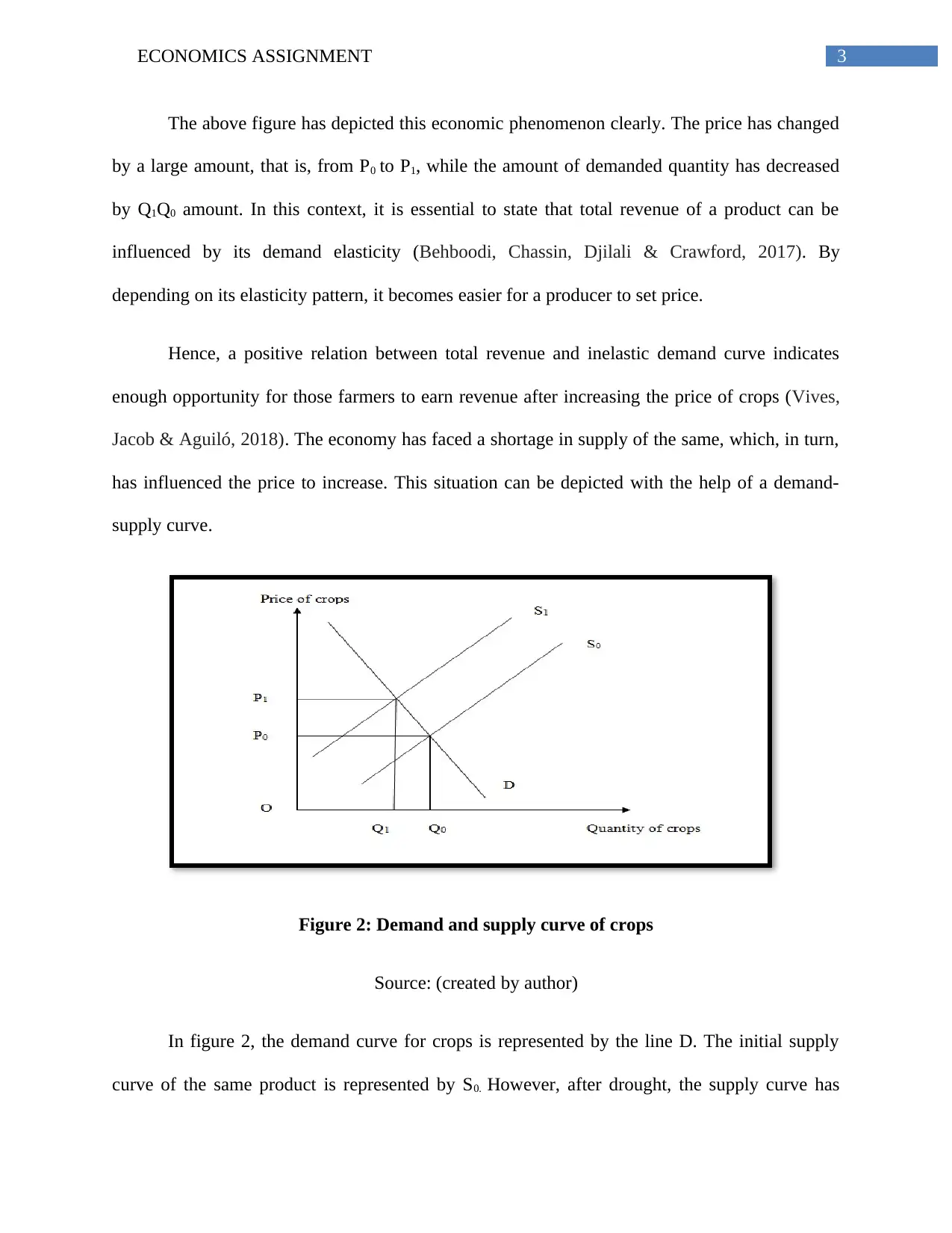
3ECONOMICS ASSIGNMENT
The above figure has depicted this economic phenomenon clearly. The price has changed
by a large amount, that is, from P0 to P1, while the amount of demanded quantity has decreased
by Q1Q0 amount. In this context, it is essential to state that total revenue of a product can be
influenced by its demand elasticity (Behboodi, Chassin, Djilali & Crawford, 2017). By
depending on its elasticity pattern, it becomes easier for a producer to set price.
Hence, a positive relation between total revenue and inelastic demand curve indicates
enough opportunity for those farmers to earn revenue after increasing the price of crops (Vives,
Jacob & Aguiló, 2018). The economy has faced a shortage in supply of the same, which, in turn,
has influenced the price to increase. This situation can be depicted with the help of a demand-
supply curve.
Figure 2: Demand and supply curve of crops
Source: (created by author)
In figure 2, the demand curve for crops is represented by the line D. The initial supply
curve of the same product is represented by S0. However, after drought, the supply curve has
The above figure has depicted this economic phenomenon clearly. The price has changed
by a large amount, that is, from P0 to P1, while the amount of demanded quantity has decreased
by Q1Q0 amount. In this context, it is essential to state that total revenue of a product can be
influenced by its demand elasticity (Behboodi, Chassin, Djilali & Crawford, 2017). By
depending on its elasticity pattern, it becomes easier for a producer to set price.
Hence, a positive relation between total revenue and inelastic demand curve indicates
enough opportunity for those farmers to earn revenue after increasing the price of crops (Vives,
Jacob & Aguiló, 2018). The economy has faced a shortage in supply of the same, which, in turn,
has influenced the price to increase. This situation can be depicted with the help of a demand-
supply curve.
Figure 2: Demand and supply curve of crops
Source: (created by author)
In figure 2, the demand curve for crops is represented by the line D. The initial supply
curve of the same product is represented by S0. However, after drought, the supply curve has
⊘ This is a preview!⊘
Do you want full access?
Subscribe today to unlock all pages.

Trusted by 1+ million students worldwide
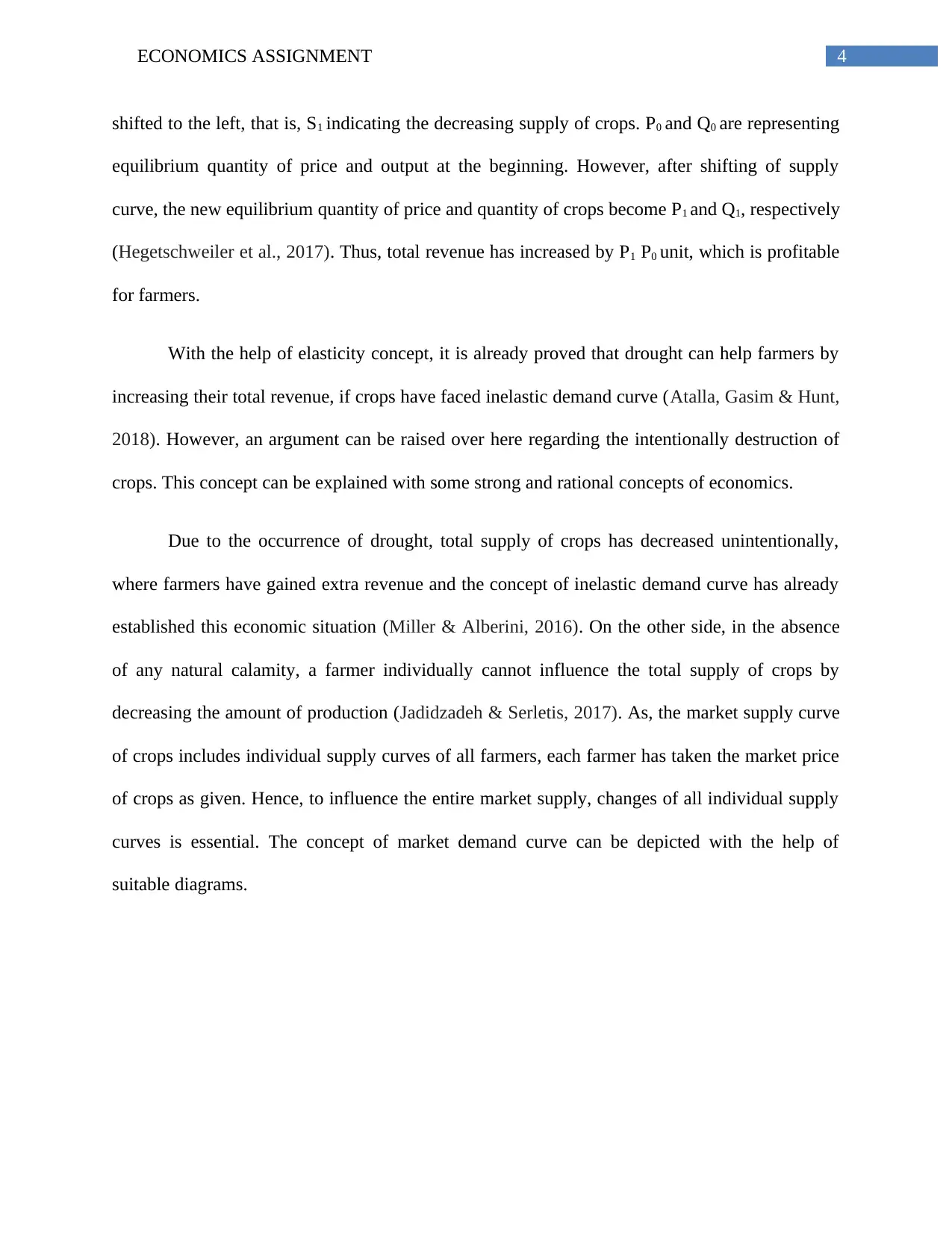
4ECONOMICS ASSIGNMENT
shifted to the left, that is, S1 indicating the decreasing supply of crops. P0 and Q0 are representing
equilibrium quantity of price and output at the beginning. However, after shifting of supply
curve, the new equilibrium quantity of price and quantity of crops become P1 and Q1, respectively
(Hegetschweiler et al., 2017). Thus, total revenue has increased by P1 P0 unit, which is profitable
for farmers.
With the help of elasticity concept, it is already proved that drought can help farmers by
increasing their total revenue, if crops have faced inelastic demand curve (Atalla, Gasim & Hunt,
2018). However, an argument can be raised over here regarding the intentionally destruction of
crops. This concept can be explained with some strong and rational concepts of economics.
Due to the occurrence of drought, total supply of crops has decreased unintentionally,
where farmers have gained extra revenue and the concept of inelastic demand curve has already
established this economic situation (Miller & Alberini, 2016). On the other side, in the absence
of any natural calamity, a farmer individually cannot influence the total supply of crops by
decreasing the amount of production (Jadidzadeh & Serletis, 2017). As, the market supply curve
of crops includes individual supply curves of all farmers, each farmer has taken the market price
of crops as given. Hence, to influence the entire market supply, changes of all individual supply
curves is essential. The concept of market demand curve can be depicted with the help of
suitable diagrams.
shifted to the left, that is, S1 indicating the decreasing supply of crops. P0 and Q0 are representing
equilibrium quantity of price and output at the beginning. However, after shifting of supply
curve, the new equilibrium quantity of price and quantity of crops become P1 and Q1, respectively
(Hegetschweiler et al., 2017). Thus, total revenue has increased by P1 P0 unit, which is profitable
for farmers.
With the help of elasticity concept, it is already proved that drought can help farmers by
increasing their total revenue, if crops have faced inelastic demand curve (Atalla, Gasim & Hunt,
2018). However, an argument can be raised over here regarding the intentionally destruction of
crops. This concept can be explained with some strong and rational concepts of economics.
Due to the occurrence of drought, total supply of crops has decreased unintentionally,
where farmers have gained extra revenue and the concept of inelastic demand curve has already
established this economic situation (Miller & Alberini, 2016). On the other side, in the absence
of any natural calamity, a farmer individually cannot influence the total supply of crops by
decreasing the amount of production (Jadidzadeh & Serletis, 2017). As, the market supply curve
of crops includes individual supply curves of all farmers, each farmer has taken the market price
of crops as given. Hence, to influence the entire market supply, changes of all individual supply
curves is essential. The concept of market demand curve can be depicted with the help of
suitable diagrams.
Paraphrase This Document
Need a fresh take? Get an instant paraphrase of this document with our AI Paraphraser
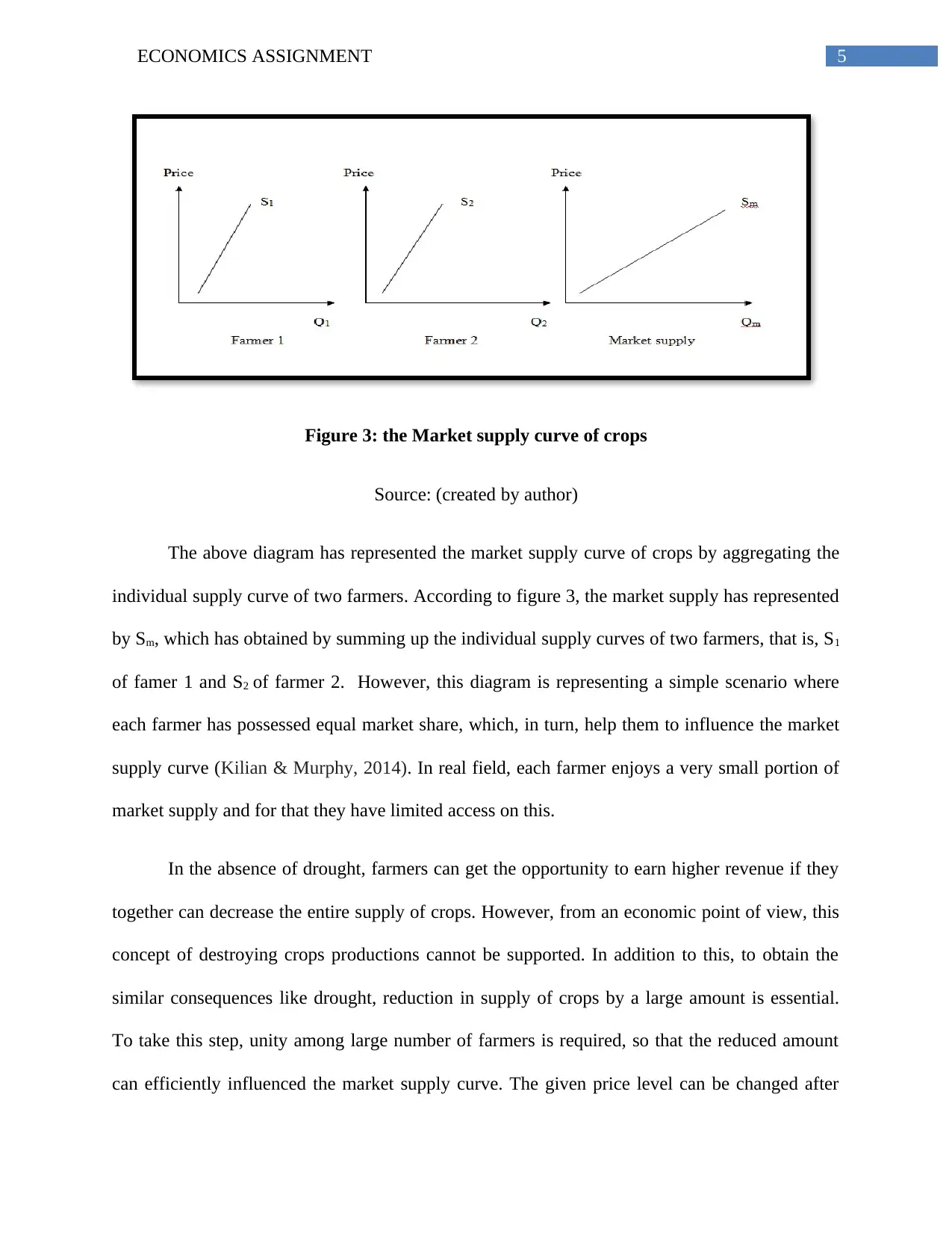
5ECONOMICS ASSIGNMENT
Figure 3: the Market supply curve of crops
Source: (created by author)
The above diagram has represented the market supply curve of crops by aggregating the
individual supply curve of two farmers. According to figure 3, the market supply has represented
by Sm, which has obtained by summing up the individual supply curves of two farmers, that is, S1
of famer 1 and S2 of farmer 2. However, this diagram is representing a simple scenario where
each farmer has possessed equal market share, which, in turn, help them to influence the market
supply curve (Kilian & Murphy, 2014). In real field, each farmer enjoys a very small portion of
market supply and for that they have limited access on this.
In the absence of drought, farmers can get the opportunity to earn higher revenue if they
together can decrease the entire supply of crops. However, from an economic point of view, this
concept of destroying crops productions cannot be supported. In addition to this, to obtain the
similar consequences like drought, reduction in supply of crops by a large amount is essential.
To take this step, unity among large number of farmers is required, so that the reduced amount
can efficiently influenced the market supply curve. The given price level can be changed after
Figure 3: the Market supply curve of crops
Source: (created by author)
The above diagram has represented the market supply curve of crops by aggregating the
individual supply curve of two farmers. According to figure 3, the market supply has represented
by Sm, which has obtained by summing up the individual supply curves of two farmers, that is, S1
of famer 1 and S2 of farmer 2. However, this diagram is representing a simple scenario where
each farmer has possessed equal market share, which, in turn, help them to influence the market
supply curve (Kilian & Murphy, 2014). In real field, each farmer enjoys a very small portion of
market supply and for that they have limited access on this.
In the absence of drought, farmers can get the opportunity to earn higher revenue if they
together can decrease the entire supply of crops. However, from an economic point of view, this
concept of destroying crops productions cannot be supported. In addition to this, to obtain the
similar consequences like drought, reduction in supply of crops by a large amount is essential.
To take this step, unity among large number of farmers is required, so that the reduced amount
can efficiently influenced the market supply curve. The given price level can be changed after
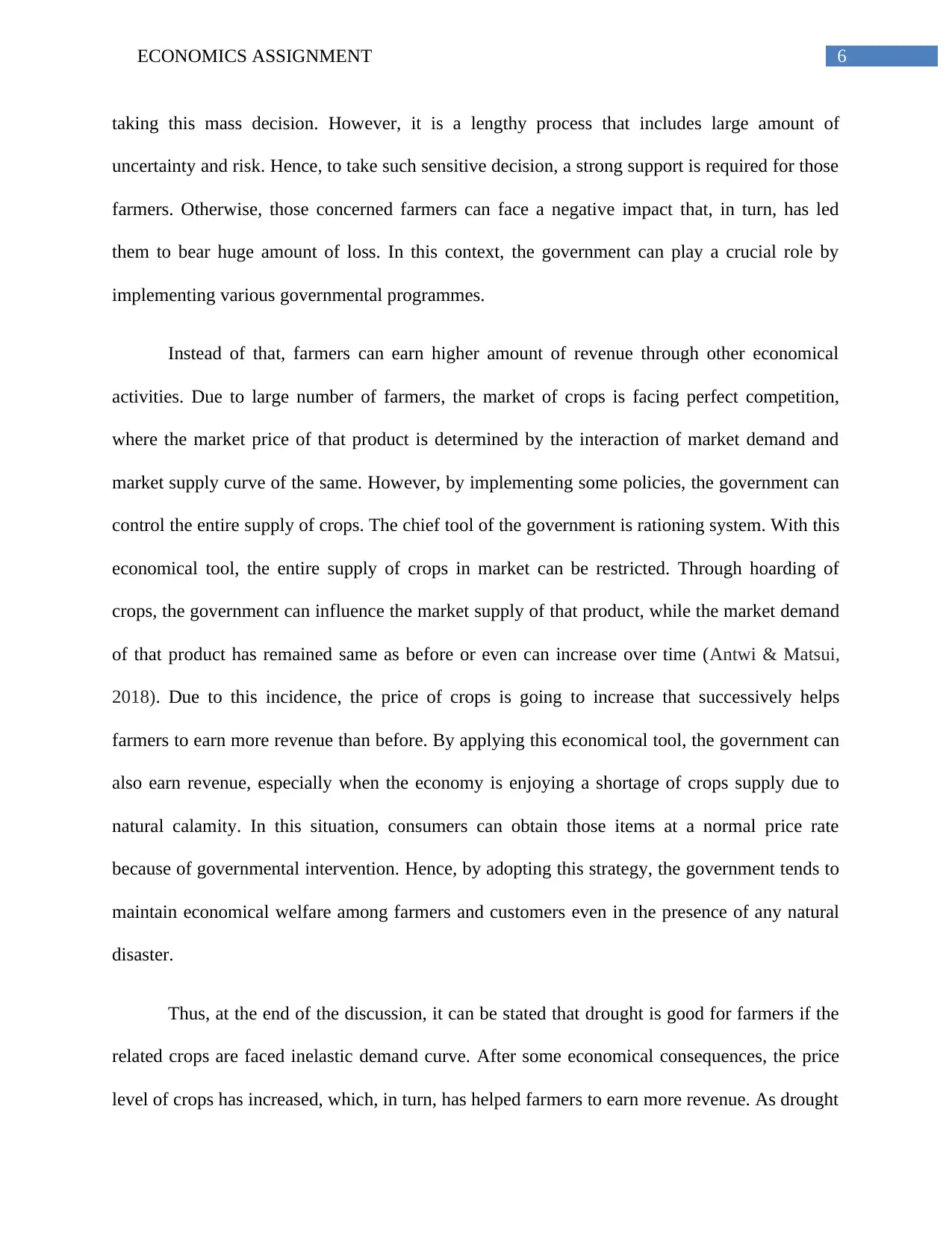
6ECONOMICS ASSIGNMENT
taking this mass decision. However, it is a lengthy process that includes large amount of
uncertainty and risk. Hence, to take such sensitive decision, a strong support is required for those
farmers. Otherwise, those concerned farmers can face a negative impact that, in turn, has led
them to bear huge amount of loss. In this context, the government can play a crucial role by
implementing various governmental programmes.
Instead of that, farmers can earn higher amount of revenue through other economical
activities. Due to large number of farmers, the market of crops is facing perfect competition,
where the market price of that product is determined by the interaction of market demand and
market supply curve of the same. However, by implementing some policies, the government can
control the entire supply of crops. The chief tool of the government is rationing system. With this
economical tool, the entire supply of crops in market can be restricted. Through hoarding of
crops, the government can influence the market supply of that product, while the market demand
of that product has remained same as before or even can increase over time (Antwi & Matsui,
2018). Due to this incidence, the price of crops is going to increase that successively helps
farmers to earn more revenue than before. By applying this economical tool, the government can
also earn revenue, especially when the economy is enjoying a shortage of crops supply due to
natural calamity. In this situation, consumers can obtain those items at a normal price rate
because of governmental intervention. Hence, by adopting this strategy, the government tends to
maintain economical welfare among farmers and customers even in the presence of any natural
disaster.
Thus, at the end of the discussion, it can be stated that drought is good for farmers if the
related crops are faced inelastic demand curve. After some economical consequences, the price
level of crops has increased, which, in turn, has helped farmers to earn more revenue. As drought
taking this mass decision. However, it is a lengthy process that includes large amount of
uncertainty and risk. Hence, to take such sensitive decision, a strong support is required for those
farmers. Otherwise, those concerned farmers can face a negative impact that, in turn, has led
them to bear huge amount of loss. In this context, the government can play a crucial role by
implementing various governmental programmes.
Instead of that, farmers can earn higher amount of revenue through other economical
activities. Due to large number of farmers, the market of crops is facing perfect competition,
where the market price of that product is determined by the interaction of market demand and
market supply curve of the same. However, by implementing some policies, the government can
control the entire supply of crops. The chief tool of the government is rationing system. With this
economical tool, the entire supply of crops in market can be restricted. Through hoarding of
crops, the government can influence the market supply of that product, while the market demand
of that product has remained same as before or even can increase over time (Antwi & Matsui,
2018). Due to this incidence, the price of crops is going to increase that successively helps
farmers to earn more revenue than before. By applying this economical tool, the government can
also earn revenue, especially when the economy is enjoying a shortage of crops supply due to
natural calamity. In this situation, consumers can obtain those items at a normal price rate
because of governmental intervention. Hence, by adopting this strategy, the government tends to
maintain economical welfare among farmers and customers even in the presence of any natural
disaster.
Thus, at the end of the discussion, it can be stated that drought is good for farmers if the
related crops are faced inelastic demand curve. After some economical consequences, the price
level of crops has increased, which, in turn, has helped farmers to earn more revenue. As drought
⊘ This is a preview!⊘
Do you want full access?
Subscribe today to unlock all pages.

Trusted by 1+ million students worldwide
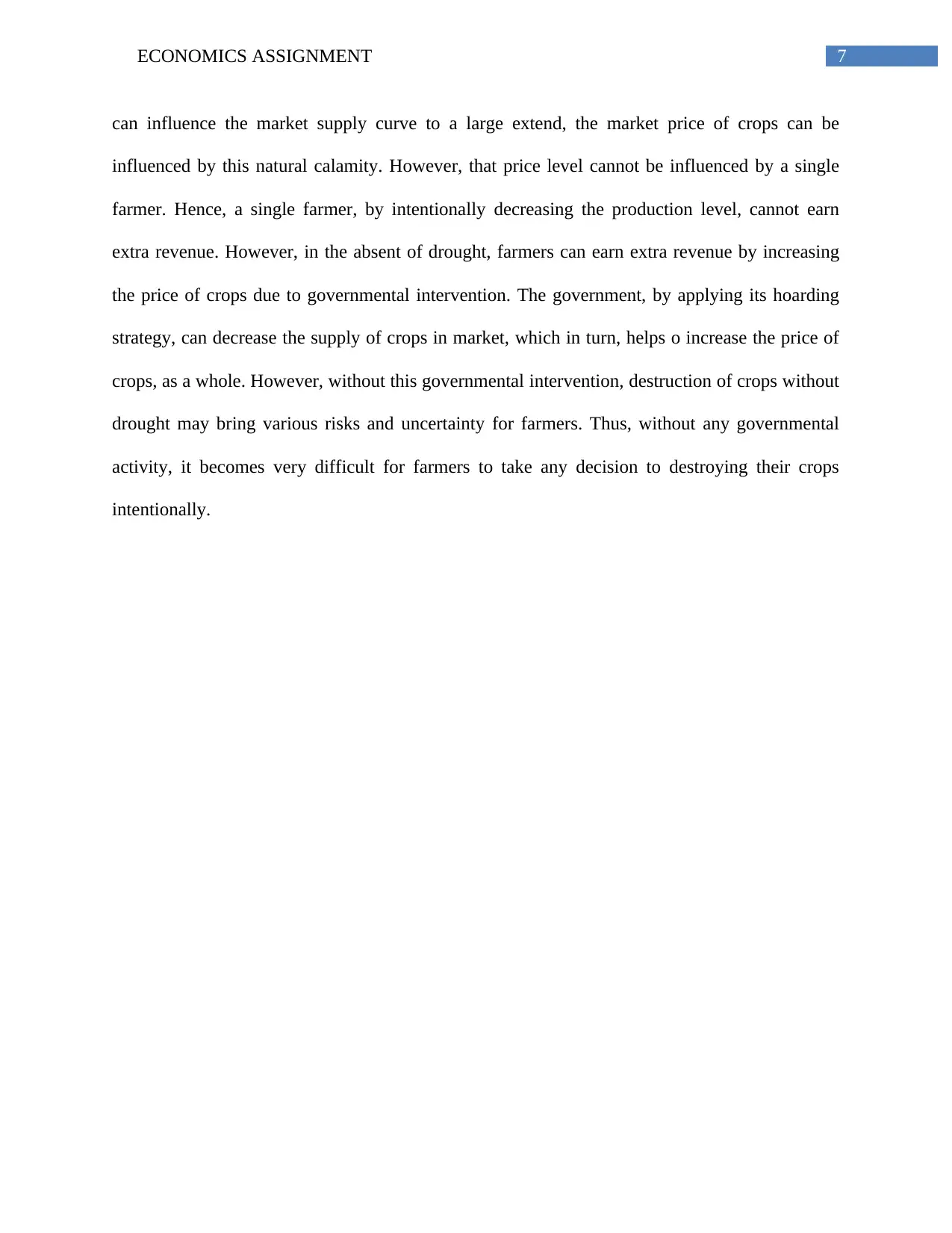
7ECONOMICS ASSIGNMENT
can influence the market supply curve to a large extend, the market price of crops can be
influenced by this natural calamity. However, that price level cannot be influenced by a single
farmer. Hence, a single farmer, by intentionally decreasing the production level, cannot earn
extra revenue. However, in the absent of drought, farmers can earn extra revenue by increasing
the price of crops due to governmental intervention. The government, by applying its hoarding
strategy, can decrease the supply of crops in market, which in turn, helps o increase the price of
crops, as a whole. However, without this governmental intervention, destruction of crops without
drought may bring various risks and uncertainty for farmers. Thus, without any governmental
activity, it becomes very difficult for farmers to take any decision to destroying their crops
intentionally.
can influence the market supply curve to a large extend, the market price of crops can be
influenced by this natural calamity. However, that price level cannot be influenced by a single
farmer. Hence, a single farmer, by intentionally decreasing the production level, cannot earn
extra revenue. However, in the absent of drought, farmers can earn extra revenue by increasing
the price of crops due to governmental intervention. The government, by applying its hoarding
strategy, can decrease the supply of crops in market, which in turn, helps o increase the price of
crops, as a whole. However, without this governmental intervention, destruction of crops without
drought may bring various risks and uncertainty for farmers. Thus, without any governmental
activity, it becomes very difficult for farmers to take any decision to destroying their crops
intentionally.
Paraphrase This Document
Need a fresh take? Get an instant paraphrase of this document with our AI Paraphraser
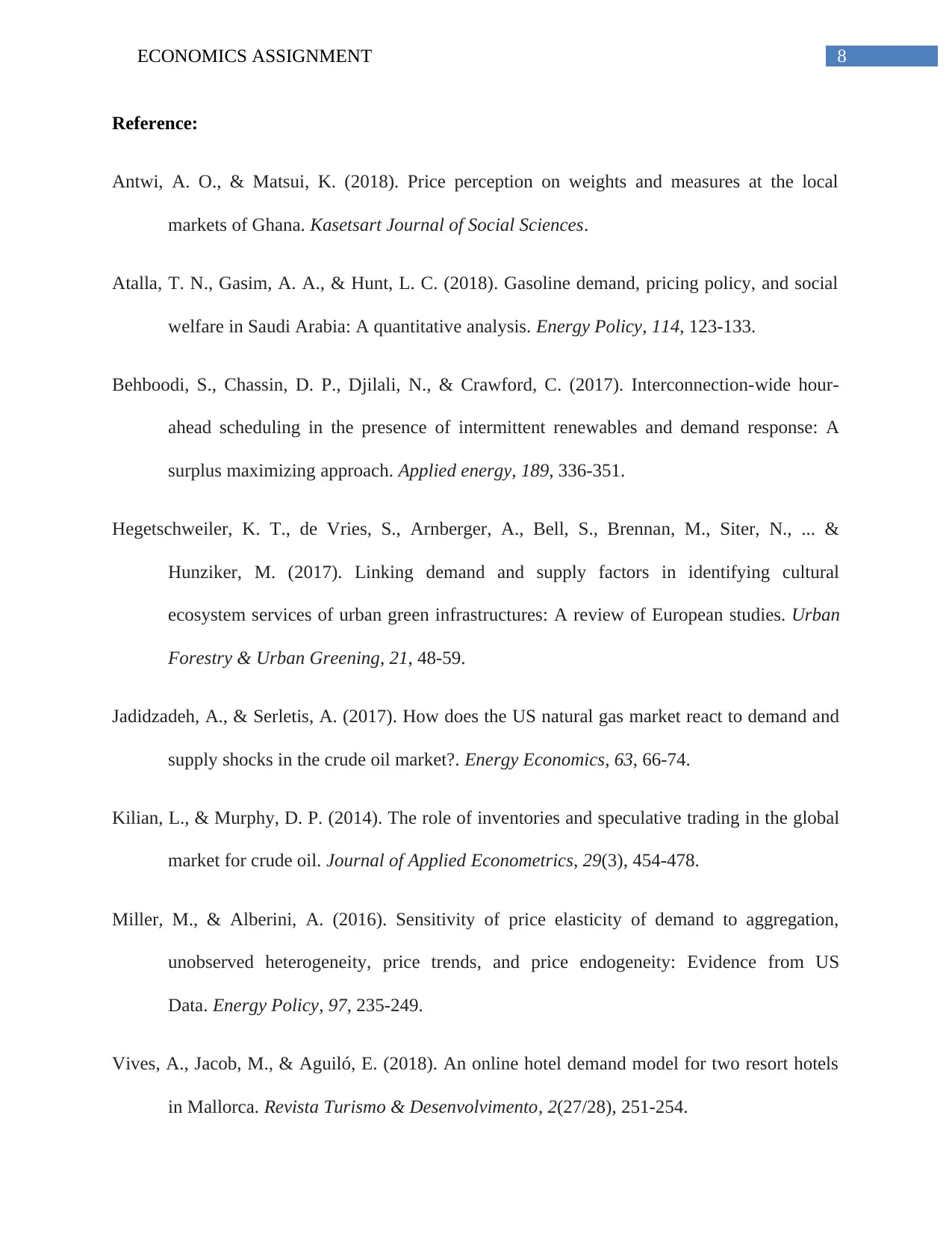
8ECONOMICS ASSIGNMENT
Reference:
Antwi, A. O., & Matsui, K. (2018). Price perception on weights and measures at the local
markets of Ghana. Kasetsart Journal of Social Sciences.
Atalla, T. N., Gasim, A. A., & Hunt, L. C. (2018). Gasoline demand, pricing policy, and social
welfare in Saudi Arabia: A quantitative analysis. Energy Policy, 114, 123-133.
Behboodi, S., Chassin, D. P., Djilali, N., & Crawford, C. (2017). Interconnection-wide hour-
ahead scheduling in the presence of intermittent renewables and demand response: A
surplus maximizing approach. Applied energy, 189, 336-351.
Hegetschweiler, K. T., de Vries, S., Arnberger, A., Bell, S., Brennan, M., Siter, N., ... &
Hunziker, M. (2017). Linking demand and supply factors in identifying cultural
ecosystem services of urban green infrastructures: A review of European studies. Urban
Forestry & Urban Greening, 21, 48-59.
Jadidzadeh, A., & Serletis, A. (2017). How does the US natural gas market react to demand and
supply shocks in the crude oil market?. Energy Economics, 63, 66-74.
Kilian, L., & Murphy, D. P. (2014). The role of inventories and speculative trading in the global
market for crude oil. Journal of Applied Econometrics, 29(3), 454-478.
Miller, M., & Alberini, A. (2016). Sensitivity of price elasticity of demand to aggregation,
unobserved heterogeneity, price trends, and price endogeneity: Evidence from US
Data. Energy Policy, 97, 235-249.
Vives, A., Jacob, M., & Aguiló, E. (2018). An online hotel demand model for two resort hotels
in Mallorca. Revista Turismo & Desenvolvimento, 2(27/28), 251-254.
Reference:
Antwi, A. O., & Matsui, K. (2018). Price perception on weights and measures at the local
markets of Ghana. Kasetsart Journal of Social Sciences.
Atalla, T. N., Gasim, A. A., & Hunt, L. C. (2018). Gasoline demand, pricing policy, and social
welfare in Saudi Arabia: A quantitative analysis. Energy Policy, 114, 123-133.
Behboodi, S., Chassin, D. P., Djilali, N., & Crawford, C. (2017). Interconnection-wide hour-
ahead scheduling in the presence of intermittent renewables and demand response: A
surplus maximizing approach. Applied energy, 189, 336-351.
Hegetschweiler, K. T., de Vries, S., Arnberger, A., Bell, S., Brennan, M., Siter, N., ... &
Hunziker, M. (2017). Linking demand and supply factors in identifying cultural
ecosystem services of urban green infrastructures: A review of European studies. Urban
Forestry & Urban Greening, 21, 48-59.
Jadidzadeh, A., & Serletis, A. (2017). How does the US natural gas market react to demand and
supply shocks in the crude oil market?. Energy Economics, 63, 66-74.
Kilian, L., & Murphy, D. P. (2014). The role of inventories and speculative trading in the global
market for crude oil. Journal of Applied Econometrics, 29(3), 454-478.
Miller, M., & Alberini, A. (2016). Sensitivity of price elasticity of demand to aggregation,
unobserved heterogeneity, price trends, and price endogeneity: Evidence from US
Data. Energy Policy, 97, 235-249.
Vives, A., Jacob, M., & Aguiló, E. (2018). An online hotel demand model for two resort hotels
in Mallorca. Revista Turismo & Desenvolvimento, 2(27/28), 251-254.
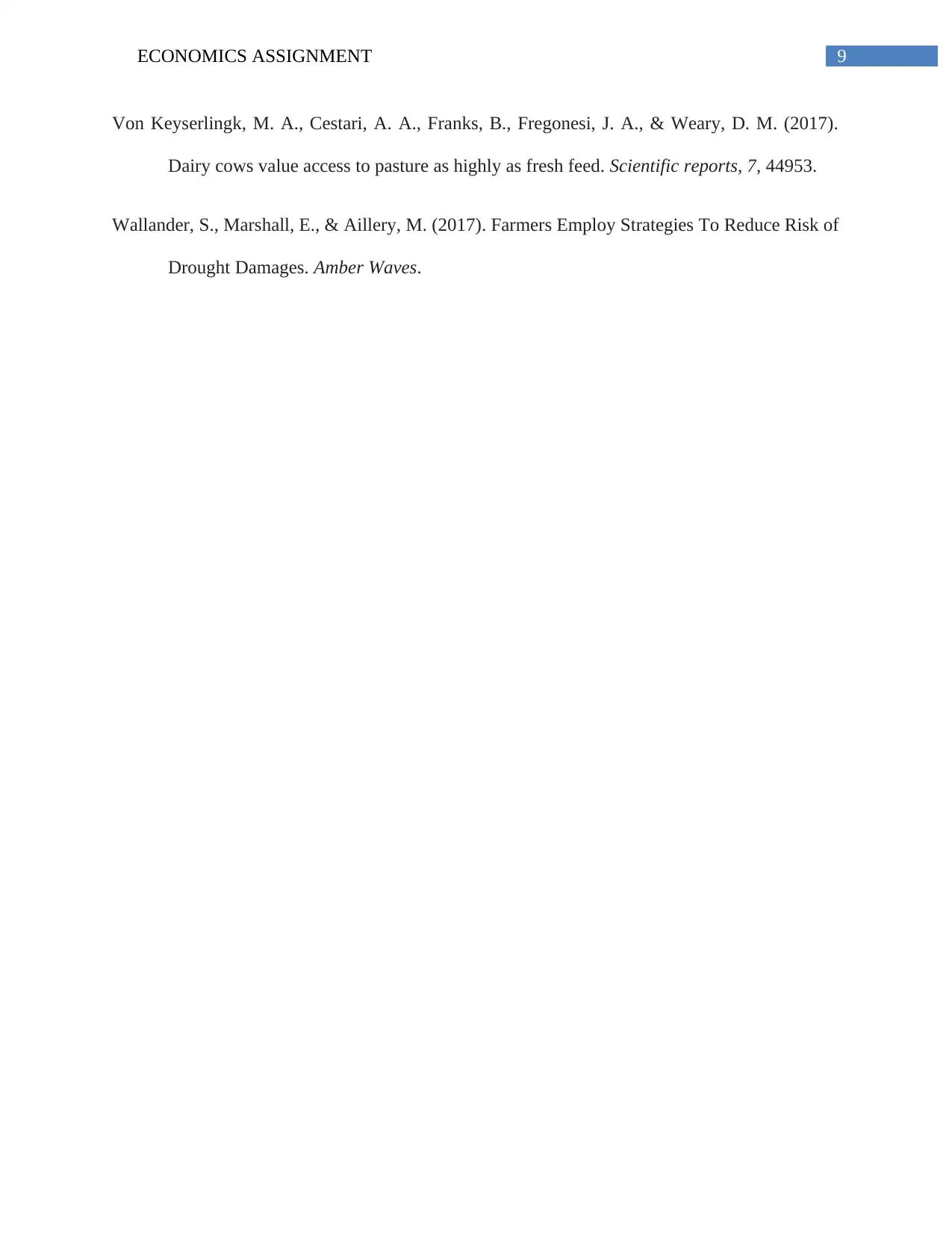
9ECONOMICS ASSIGNMENT
Von Keyserlingk, M. A., Cestari, A. A., Franks, B., Fregonesi, J. A., & Weary, D. M. (2017).
Dairy cows value access to pasture as highly as fresh feed. Scientific reports, 7, 44953.
Wallander, S., Marshall, E., & Aillery, M. (2017). Farmers Employ Strategies To Reduce Risk of
Drought Damages. Amber Waves.
Von Keyserlingk, M. A., Cestari, A. A., Franks, B., Fregonesi, J. A., & Weary, D. M. (2017).
Dairy cows value access to pasture as highly as fresh feed. Scientific reports, 7, 44953.
Wallander, S., Marshall, E., & Aillery, M. (2017). Farmers Employ Strategies To Reduce Risk of
Drought Damages. Amber Waves.
⊘ This is a preview!⊘
Do you want full access?
Subscribe today to unlock all pages.

Trusted by 1+ million students worldwide
1 out of 9
Related Documents
Your All-in-One AI-Powered Toolkit for Academic Success.
+13062052269
info@desklib.com
Available 24*7 on WhatsApp / Email
![[object Object]](/_next/static/media/star-bottom.7253800d.svg)
Unlock your academic potential
Copyright © 2020–2025 A2Z Services. All Rights Reserved. Developed and managed by ZUCOL.





